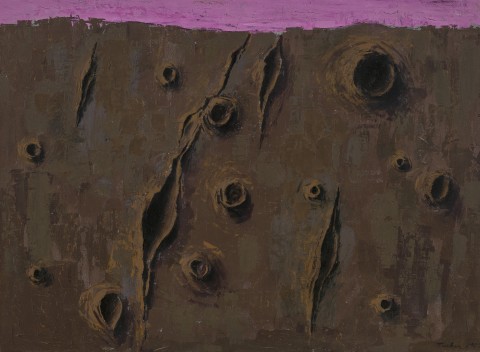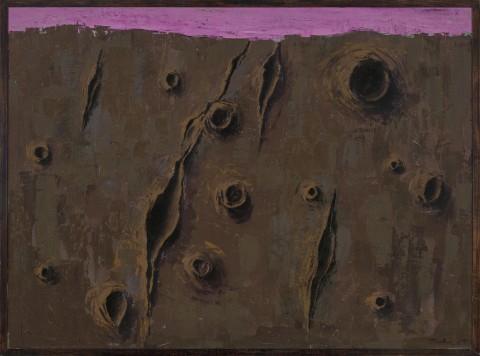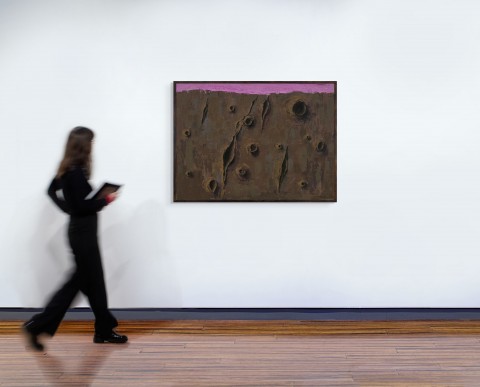(1914 - 1999)
Albert Tucker
Lunar landscape, 1957
synthetic polymer paint on composition board
Poindexter Gallery, New York
The Museum of Modern Art, New York, acquired from the above in April 1958 (label attached verso)
Paintings - Albert Tucker, Imperial Institute, London, 11 April – 8 May 1957, cat. 26
Recent Acquisitions – Painting and Sculpture, Museum of Modern Art, New York, USA, 30 January – 19 April 1959
Albert Tucker: A Retrospective, National Gallery of Victoria, Melbourne, 21 June - 12 August 1990 (label attached verso)
Albert Tucker letter to Sidney Nolan, 26 April 1958, in McCaughey, P. (ed.), Bert & Ned: The Correspondence of Albert Tucker and Sidney Nolan, The Miegunyah Press, Melbourne, 2006, pp. 192, 193 (illus.)
Recent Acquisitions checklist with notes, Museum of Modern Art, New York, 1959, pp. 5 – 6
Feldman, R., 'Australian artist paints with cement', The Australian Women's Weekly, Sydney, 9 September 1959, p. 11
Uhl, C., Albert Tucker, Lansdowne Press, Melbourne, 1969, cat. 10.15, p. 100
Mollison, J., & Minchin, J., Albert Tucker: A Retrospective, National Gallery of Victoria, Melbourne, 1990, pp. 53 (illus.), 115
Albert Tucker interviewed by Robin Hughes for Australian Biography: Albert Tucker, Film Australia, 14 February 1994
Fry, G., Albert Tucker, The Beagle Press, Sydney, 2005, pp. 133 (illus.), 156
Andrews, T., Albert Tucker's Grotesques, Heide Museum of Modern Art, Melbourne, 2024, p. 6
Albert Tucker left Australia for London in 1947, fleeing the trauma and hurt of his private life after his wife, artist Joy Hester, left him and their young son Sweeney for fellow artist Gray Smith. In early 1948, he settled in Paris, immersing himself in the city, its culture and its artistic riches. Living in an apartment behind the Paris Opera on the Right Bank that had once been occupied by Edvard Münch1, it was in Paris that Tucker experienced firsthand the work of the European modernists that he had studied in reproduction in Melbourne.
In 1948 Tucker travelled to Italy, where he responded deeply to the themes of birth, death and resurrection that he saw in the work of the Renaissance masters he encountered there. The depictions of extreme pain and anguish that fills many of these works no doubt resonated with his own experiences, and accordingly, he described the process of making the encrusted surfaces of his paintings of the following decade as ‘unloading the demons.’2 Tucker exhibited in Rome with his close friend and artistic rival Sidney Nolan in 1954.3 This exhibition served to introduce the work of both artists to European audiences, and importantly, align their individual practices with the broader interests of international modernism.
While together in Rome, Nolan shared his recent photographs of drought-affected Queensland with his friend. Inspired in part by the horror depicted in these images (such as the contorted forms of dead horses and the carcasses of cows hanging from trees), Tucker returned to Australian themes, developing a new and enduring motif – the craggy profile of his Antipodean Heads. Of the landscape, yet deeply affected by it, the faces of these outback ‘heroes’ are rough, and battle scarred, resilient and enduring. After being introduced to the possibilities of polyvinyl acetate (PVA) by Italian artist Alberto Burri, Tucker began to build up the surfaces of these works, creating pitted landscapes and cratered forms that also resemble the ‘wounds and gashes’4 of the early Italian religious painting that so affected him. This is achieved to powerful effect in Lunar Landscape, 1957, with its otherworldly purple sky providing a startling contrast to the almost violent lacerations that punctuate the land’s dark, pock-marked surface.
Tucker and his Californian girlfriend, Mary Dickson, left Italy for London in October 1956, settling in a large Victorian apartment not far from Paddington Station.5 Tucker was convinced that London, not the continent, was the place to make his reputation, and Lunar Landscape was included in the artist’s ‘first comprehensive show’6 at the Imperial Institute, South Kensington in April 1957. However, Tucker’s acceptance as a major proponent of international modernism was cemented elsewhere, in 1958, when Lunar Landscape was acquired for the collection of the Museum of Modern Art by its director Alfred J. Barr and included in the Museum’s Recent Acquisitions exhibition of 1959 alongside artists such as Adolph Gottlieb, Jasper Johns and Antoni Tàpies. This was a game-changer for the struggling artist, who recalled:
‘I saw the Museum of Modern Art [and] was delighted. I saw Nolan. We went up one day there to ... go to the Museum and they had a big sign up saying ‘New acquisitions of the past year’… And Nolan said, ‘Well let's go in and go and see what's there’, and the first painting I saw [when] I went through the door… was one half of this painting of mine [Lunar Landscape] on the wall… And Nolan said, ‘Let's go up and have a cup of coffee’ to their restaurant on the third floor, which we did. So we went around, got into the elevator and… another man got in. A tall, rather grey spare man got into the elevator with us and Nolan looked at him and said… ‘Oh, oh hello Mr. Barr, how are you?’ And Mr Barr looks, ‘Oh hello, hello Mr. Nolan, how are you?’ and so on. And he said, ‘Did you see... Mr. Nolan, that we have a painting of one of your compatriots just outside on the wall.’ So Nolan then... he just said, ‘Oh well, here he is’… And there I was. And so Barr was quite delighted… he came up and he had a cup of coffee with us. We talked for half an hour. There I was, right on the top, on that level… in a flash…’6
This serendipitous acquisition by MoMA was greatly aided by Dickson who was a masterful advocate of Tucker’s work. In April 1958, after nine years together, Dickson returned to the United States, taking some of Tucker’s paintings with her and placing them at Poindexter Gallery, New York. It was here, in the Gallery’s stockroom, that Barr saw Lunar Landscape and purchased it for the Museum.7 As he said: ‘I saw this piece of insistent crudeness and recognised a master illusionist at work... [It] put me immediately in mind of the art brut school in France where painters consciously defied good taste and restraint.’8
After her homecoming, Mary broke off the relationship, and Tucker, distraught, attempted to follow her, but was unable to secure an American visa because of his limited finances (he needed to be able to demonstrate that he had enough money to buy a return fare and to support himself while there). Undeterred, he decided to go to Canada instead, so that he could earn some money and then travel down to New York to obtain a visa. To his utter surprise, the artist received a telegram while on the boat to Montreal, informing him that he had just won The Women’s Weekly Art Prize9, then the richest art prize in the Commonwealth. With his greatly changed circumstances, Tucker immediately obtained a two-year Visa:
‘So I floated out of the [Consulate]... I always have that feeling of floating... when I really achieve something or escape from something. You feel yourself rise in the air. I’m sure it was an out of the body experience. I’m sure that my inner body there lifts up two or three feet into the air and I just float out and so I’ve floated back to the YMCA, packed up everything, went down to the station, worked out the train times and hopped on a train headed for New York.’10
Albert Tucker continues to be represented in the MoMA collection, with a significant work, Explorers, Burke and Wills, 1960.
1. Transcript of Robin Hughes interview with Albert Tucker, 14 February 1994, Australian Biography: Albert Tucker, National Film and Sound Archive at https://www.nfsa.gov.au/collection/curated/asset/99512-australian-biogra... (accessed 12 May 2025)
2. Burchill, L. B., Albert Tucker: Marking the Past, Heide Museum of Modern Art, 29 February – 16 August 2020 at https://wp.heide.com.au/app/uploads/2022/09/882.2020_MarkingThePast.pdf (accessed 12 May 2025)
3. Mostra dei Pittori Australiani: Albert Tucker e Sidney Nolan, Associazione della Stampa Estera, Via della Mercede, 54, Roma, 20 – 31 May 1954.
4. Transcript of James Gleeson interview with Albert Tucker, 2 May 1979, James Gleeson Oral History Collection, National Gallery of Australia at https://nga.gov.au/media/dd/documents/tucker.pdf (accessed 12 May 2025)
5. Burke, J., Australian Gothic: A Life of Albert Tucker, Knopf, Milsons Point, 2002, p. 345
6. Albert Tucker cited in Hughes, op. cit.
7. ibid.
8. Feldman, R., The Australian Women’s Weekly, 9 September 1959, p. 11, cited in Burke, op. cit., p. 351
9. Albert Tucker cited in Hughes, op. cit.
10. ibid.
KELLY GELLATLY


